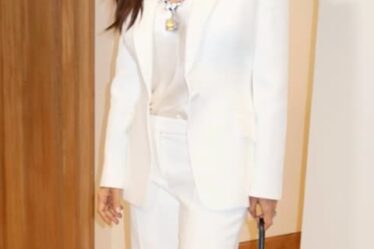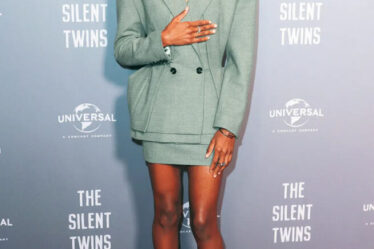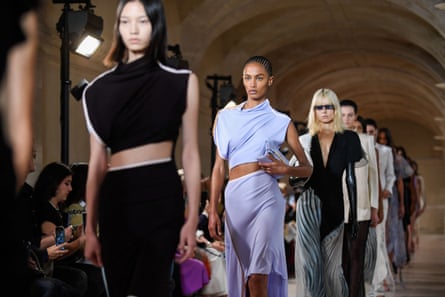
In a salmon-pink villa high on a hill above Cannes, the pop star Dua Lipa is describing the first time she sketched a dress for Donatella Versace, and sent it via text. “I can’t draw at all, so I don’t think it was very good,” she says. “But I think Donatella got what I was trying to do.” Versace nods. “I don’t normally work like this,” she laughs. “But I was like, ‘OK, she has a vision, and a talent. This can work.’”
Despite no design training and just a brief history as a model/muse for the storied Italian fashion house, Dua Lipa is the latest pop star to try her hand at designing a collection in what has become the era of the musician turned designer.
Next month, super-producer Pharrell Williams will show his first men’s collection for Louis Vuitton. This follows the late designer Virgil Abloh who, before making monogrammed LV briefcases and Italian wool suits, was a DJ/producer. Then there is Ye, Abloh’s former collaborator, who juggled music with his Yeezy fashion label, and Rihanna, whose Fenty fashion line contributed to her becoming a billionaire before it closed during the pandemic. Beyoncé recently did a couture collection with Balmain and is rumoured to be launching a beauty brand. Even Harry Styles had brief success designing socks for Gucci.
The most famous pop star to successfully make the switch is probably Victoria Beckham. Since launching her label in 2o08 with a line of soft-power dresses in pastels and black, it has evolved from the sort of slim-cut shifts Beckham wore as a Spice Girl to clothes routinely worn on red carpets and in boardrooms, as well as by Michelle Obama and the Princess of Wales.
Despite fluctuating sales, this spring Beckham’s label announced it had turned a profit for the first time. Beckham is arguably more famous as a dressmaker than a pop star, not to mention proof that it can be incredibly lucrative for a designer to embody their brand as much as the people who buy it.
Lipa is not the first pop star, then. But as a young artist with a huge following and a no-holds barred taste, she is perhaps the most relatable. The move also suggests that the major conglomerates – LVMH owns Louis Vuitton and what remains of Fenty, while Capri Holdings own Versace – are, on some level, still interested in hiring creatives capable of translating the zeitgeist rather than simply sketching a nice coat.
“Big brands need a new level of visibility these days,” celebrity PR specialist Mark Borkowski says. “Fashion isn’t just about designing clothes, it’s about the process and what these people represent. Legacy fashion houses know that the speed at which fashion changes means they need to look outside of what they know.”
“It’s not just that Dua is super-famous – she knows about clothes,” agrees Versace. “She is a young woman who wears things in a contemporary way – and that’s an important thing for an established [brand] like us to realise.” However well-known she is, “it’s important to have an outside voice”.
The show took place at sunset on a catwalk suspended over a narrow pool, overlooking the sea. Models with big, Barbarella hair marched in tight skirt suits and bright, micro-length dresses. The dresses buckled at the back, and came in shades of Barbie pink and Cote d’Azur blue.
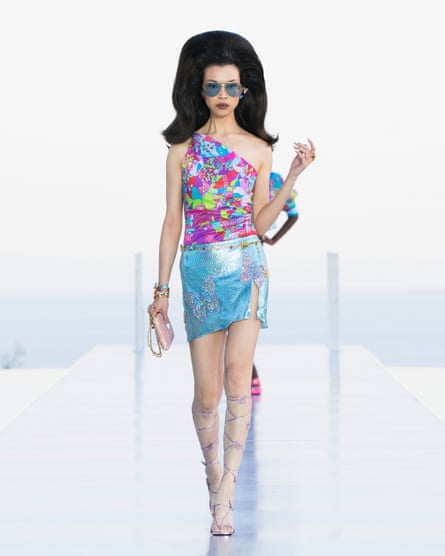
One head-to-toe towelling look was accessorised by jewelled flip-flops. Another, a blue sheath dress, was made from a clingy chain material based on the metal mesh invented by Gianni.
“These are clothes for young people – they don’t want to spend that money on mesh, so it’s a different price,” says Versace.
Lipa’s collection is young, fun and cheaper than usual Versace – a swimsuit costs just under £300 – but other dresses sit squarely in four figures. In the last quarter ending in December, Versace reported revenues of $249m, down 0.8% compared with the year before.
after newsletter promotion
According to Vogue Business, Capri Holdings is trying to grow annual sales to $2bn and is betting on a younger market. In which case, working with a young designer is an effective way to do that.
However successful the Dua Lipa collection is, the wider convergence between fashion and pop stars has rekindled an ongoing debate. Wearing the clothes is not the same as designing them, so what exactly is a fashion designer now – and is someone with good taste and social media reach enough?
“The fashion industry is one driven by optics and a certain degree of hysteria,” says Dal Chodha, a lecturer at Central St Martins. But, he says, this is not always a bad thing; fashion design can be a closed and narrow industry. Over the past decade “some of the ‘designers’ we are asked to venerate are little more than stylists themselves,” he says. Pharrell Williams has collaborated with Chanel and Moncler, as well as designers such as Kenzo’s Nigo. Karl Lagerfeld, meanwhile, never actually studied fashion.
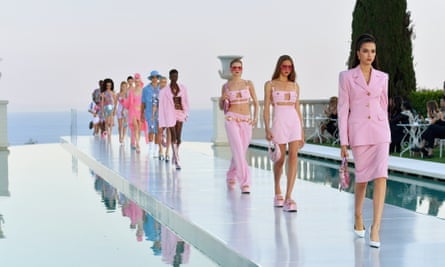
More directly, though, what does this mean for fashion students? One designer who graduated from Ravensbourne with a BA in fashion last year said he was still looking for a job. “When I see these outside names taking these top positions I just think – what was the point in doing that degree?” he says, via Instagram. “The big [fashion] houses don’t want pattern cutters any more. They just want celebrity cachet.”
Chodha agrees that “the type of student who wants to study fashion has dramatically changed in the last five years”, and cites Abloh as the main cause. However, he also thinks some students have been “emboldened by the arrival of the ‘celebrity creative director’”. “It is forcing students to work in a different way and perhaps shun the traditional system altogether,” he says.
Still, these collaborations work both ways. Pop stars need to have enough “creative arrows in their quiver to survive and expand, too”, says Borkowski. “Now that we have an unfettered access to a celebrity’s lifestyle, the era of a pop star doing a curated fashion shoot in Vogue isn’t enough,” he says. Sometimes, they have to be able to make the clothes, too.

